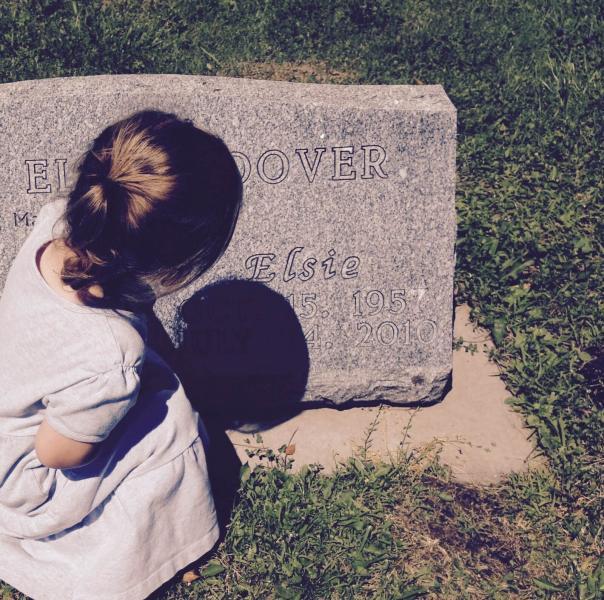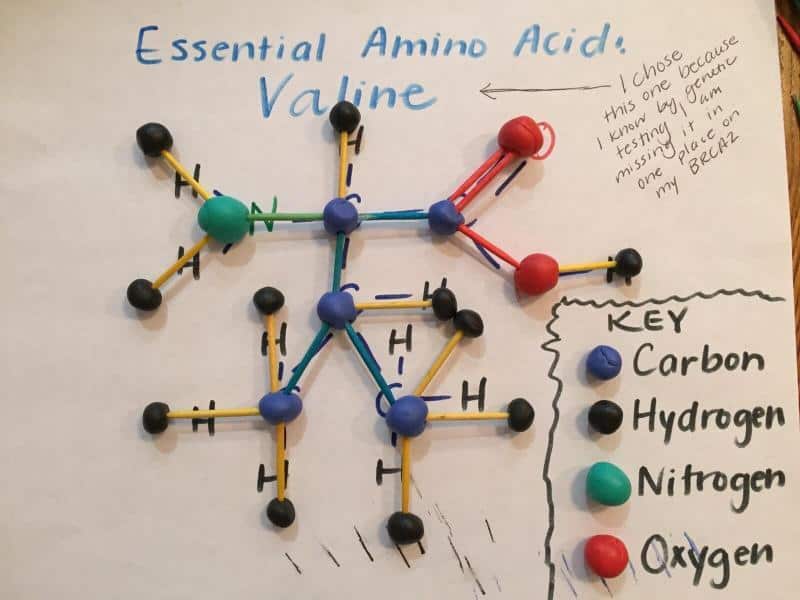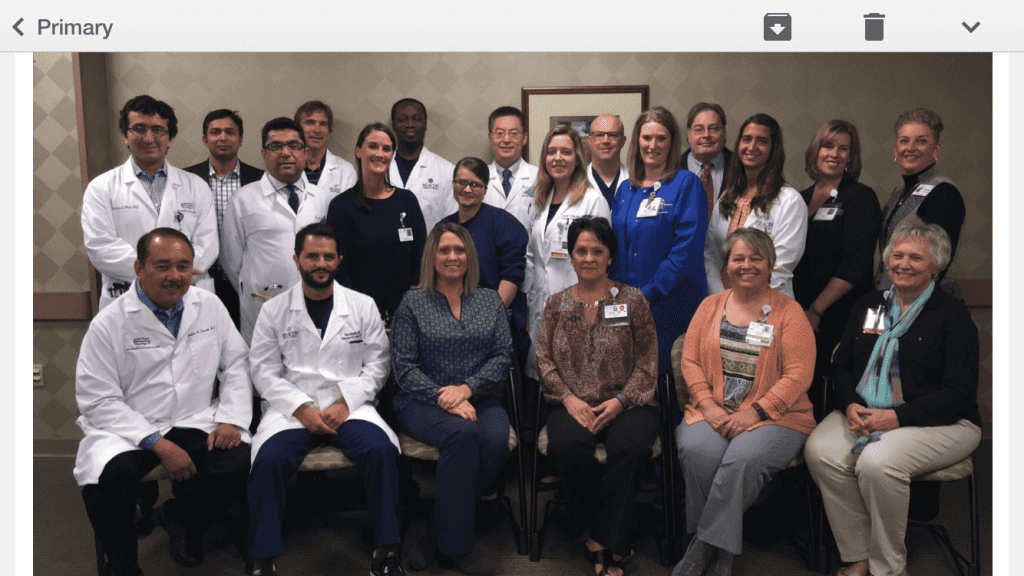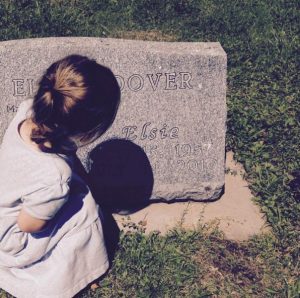I was at work the other day and things were quiet (DON’T SAY THAT WORD!!!! I can hear my co-workers say in my head, followed by NOW YOU DID IT!!), so I took the elevator down to the radiology office to pay my bill.
Now, I am all of 34 years old which is younger than the approved age for our insurance to pay for mammograms. However I have been told that since my mom died of breast cancer I should get mammograms and any insurance should pay.

Above, my niece, Mya Elsie, by my mom’s grave.
Further, this spring my genetic testing revealed that one of my breast cancer fighting proteins, BRCA2, has a slight mutation–it is missing valine, one amino acid, which potentially can injure the ability of the protein to recognize and fight cancer cells.

Last summer when insurance denied my test, I wrote them a letter saying I was high risk and that’s why I needed the test and therefore they ought to pay for it…would they rather pay for treatment of a full-blown cancer? I thought I wrote it nicely, but in a straightforward way. They nicely wrote back and said, in a straightforward way, that they should not pay for it.
So I let it go.
This summer, I got my regular mammogram and then was called back in for a diagnostic mammogram to clarify an unclear area. I was alarmed, but it turned out to be nothing, thankfully.
A few weeks later the thin envelopes arrived in my mailbox with the bill, saying that insurance had again denied part of the testing, but about half of the cost was still being sent to insurance.I thought that was a good sign and I was hoping they would pay at least half, because the total bill was now $660.
I arrived at the sliding glass window and announced I had arrived to pay my bill, but that I believed part had been sent to insurance.
The clerk checked the computer.
“They denied that part too,” she said sympathetically.
I was prepared to pay, but suddenly I felt frustrated and sad. I didn’t feel exactly mad… I know there are people with much bigger bills, and I know I shouldn’t complain about paying for an elective test. But, their refusal to pay for the test struck an unexpected emotional vein.
The clerk was very nice and agreed it was a bit ridiculous and suggested I look into it before paying.
I wandered away and made a call to my family doctor without much confidence. Even though they had ordered the tests for me, there was probably nothing they could do. I left a message.
My throat felt just a bit tight, that subtle oozing of sadness..
If only I could talk to Dr. Patel!
Dr. Patel is an Elkhart General radiologist who is also heavily involved with the American College of Radiology. I remember asking him about the rules for how often a person should get a mammogram, and he proceeded to tell me the national guidelines.
“I actually helped write them,” he said, with a laugh.
A small, pleasant man who laughs about his ancestors coming to America on a boat, Dr. Patel is the radiology expert we turn to for the reading of difficult or unusual tests. And he seems to care that things are done correctly and above average. When he sits at his computer and radiology screens and scrolls through a CT scan or a cardiac MRI, it’s like watching a surgeon tie knots… so fast, so fluid, so adept, images snapping and flashing, terms unfamiliar to me whirling through the air. In fact, one of the nurses who work with him told me one day, that Dr. Patel is “the Dr. Halloran of radiology,” which was a nice double compliment. He is likely at least part of the reason our cancer program recently got recognized nationally.

I wanted to go and see if he was in his radiology office behind the breast cancer center and tell him the story and see if he could make any suggestions about my predicament.
I even debated it briefly, but I decided that it wasn’t fair. First of all even though he was a pleasant man and probably would listen to me, it wasn’t fair of me to interrupt him when he wasn’t my doctor. Secondly, he would probably know my face from having seen me with the heart surgeons, but it didn’t feel fair to use my connection with them to get him to talk to me either. Third, he probably would know what to do and perhaps would be heard because he was such an important person, but I didn’t really feel fair to request that of him either.
But as I thought on these things, I decided to wander over to the breast center. Since this was their specialty, perhaps the staff there would know what I could do from their experiences with other patients.
I walked into the pinkly decorated waiting room and up to the desk.
“Can I help you?” asked the woman at the computer.
“Is Dr. Patel in?” I couldn’t resist asking.
“Yes,” she said with a raised eyebrow tone of voice. I totally understood… you don’t walk up and just ask to see the doctor without an appointment.
Remembering my resolve, I declined to ask to see him.
“That’s fine,” I said. “Maybe I’ll talk to him sometime.”
I explained my problem to the girl behind the desk.
She listened sympathetically.
“Why don’t you talk to the nurse?” She said. “Just a second.”
In a moment, she ushered me back to a room where a pleasant mammography nurse was sitting.
As I took a seat, who should walk by with the paper but the radiology expert himself.
“Dr. Patel, come in,” the nurse said, and I realized she was inviting him to hear my story.
I explained that my mom was diagnosed with breast cancer at a young age and had then passed away, and that I had been reassured that insurance should pay for my testing.
“I’m not living in poverty,” I said. “It’s not that I can’t pay it, but it seems ridiculous if the guidelines tell you to get tested that insurance won’t pay. It doesn’t seem right.”
“Those guidelines are written down,” Dr. Patel said, forgetting to remind me that he had helped write them. “You should start testing ten years before your mom was diagnosed.”
“And I do have a BRCA-2 mutation,” I added (the breast cancer-fighting protein). “They said it’s not a bad one, just one amino acid, but…”
Dr. Patel stared at me now.
“That alone is a reason to get tested, even without family history of cancer.”
He pulled out a piece of paper and wrote something down.
Surprised tears sprang to my eyes as if that vein of sadness I had felt earlier was oozing into my eye sockets.
“I’m going to email the head of Human Resources for Beacon Health System.”
“Thank you so much,” I said, the tears now seeming to be dripping into my voice.
I thanked the nurse as well, who had not only welcomed me into her office without an appointment, but had welcomed Dr. Patel in to help solve the mystery.
I was heading for the door when I stopped and walked back to the woman behind the desk who I had talked to first.
“Thank you so much,” I said.
“You’re welcome,” she said. “Good timing!”
Usually, at the hospital, I’m the one called upon to give compassion and help with problems.
Here, in about 15 minutes, I had been the recipient of the kindness of four people.
And I think, the special gift of God’s timing. By remarking that the timing was good, it was evident that the woman had not called for Dr. Patel.
After reading your riveting entries all week on my blog and Facebook page of stories of kindness, I found myself with another story of my own.
Perhaps the insurance company will not budge. Regardless of what happens, the beauty of being the recipient of kindness and care and God’s gift that day–two days before my moms birthday, October 15, by the way!– will be stamped forever on the pages of my life experiences, beside the other memories, happy and sad.
She would be 59.






2 thoughts on “Good Timing”
Aw. This post nearly made me cry. Today is the one day out of the year that our moms shared the same age. Your mom would gleefully rub it in when they were girls; my mom returned the favor when they were 40ish.
I’m glad God gave you Dr. Patel’s kindness two days before this birthday ???? So sweet of God.
I was just thinking of their competition as well. And yes, it was so clearly God’s hand.